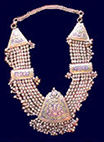
 Ornaments
are an important part of the dress of the people
of Kullu
Ornaments
are an important part of the dress of the people
of Kullu  .
The Valley offers typical and distinct design of ornaments which
makes it different from the rest.
.
The Valley offers typical and distinct design of ornaments which
makes it different from the rest.
Himalayan women satisfy their craze with silver and other less
costly metals. Both men and women used to wear a lot of jewellery
in the past but now a days only women wear jewellery on special
occassions like local fairs
 ,
festivals
,
festivals  and marriages
and marriages  .
.
Earlier these ornaments were heavily made with bold designs of
flora and fauna of the valley and were worn on the head, forehead,
nose, ears, neck, arms, wrists, fingers, ankles and toes. The
ornaments made these days are light and practical, keeping in
mind the need of working women and the designs are mostly traditional.
Many local goldsmiths are involved in making beautiful jewellery,
upkeeping their family traditions.
Metals Used
Silver, gold and guilt are the metals mainly used for making ornaments.
Traditionally, silver was used as it was easily available in the
valley and was very cheap, but the rich families preferred gold.
Traditional
Designs:
Nose Ornaments
- Laung - a nose stud which is a dailywear and is made of gold.
- Balu - a nose ring made of gold.
- Fuli - is a ring worn under the bridge of the nose and is
smaller than a Balu in size.
Head ornaments
- Tunki - It is made of silver and is used to cover the parting
of the hair.
- Tora - It is made of silver and is like a hairband.
- Tika - It is an elaborate design with the combination of Tunki
and Tora.
Ornaments for Pattu

Boomani - Silver or gold needles joined together with chains.
It is used to tie up pattu (local dress).
Feet Ornaments
- Jhanjar - It is made of silver and is worn on the ankle. It
is 3 to 4 inches wide.
- Bichhwa - It is like a ring but is worn on the toes.
Ear ornaments
- Khundi - It is a small golden or silver earring worn on the
upper part of the ear.
- Bali - It is a big golden ring.
Finger Ornaments
- Guthi - It is a golden ring in shape of a diamond.
- Chhalai - It is in the shape of a band.
Arm Ornaments
- Toka - It is a flat silver bracelet, which is around 4"
broad and has a design on it.
- Kangnu - It is a silver bracelet with heads of tigers engraved
on the ends.
- Jalibandh - It is 4" broad silver band having intricate
net for the design on it. It has small bells on one side (gungroo).
Two ends of the bracelet are joined with the help of a nut.
It is mostly worn in marriages and fairs.
Neck Ornaments
- Sikkamala - It is a silver necklace of coins. The coins are
of the British era. This is also worn for the special occasions
like marriages and fairs.
- Chandrahar - It is made of silver and is worn during marriages
and fairs.
- Mendkumala - It is similar to Jaumala but the pendants are
smaller in size and slightly round in shape. This is used as
a daily wear.
- Jaumala - It is made up of silver pendants, which is in shape
of barley. This is used as a daily wear.
- Ghungroomala - It is made up of small silver hollow beads.
They are used as a daily wear.
Some traditional jewellery like chandrahar, sikkamala, etc. is
worn during marriages and fairs. Bride wears a traditional Balu
(a nose ornament made up of gold); which is basically given by
maternal uncle as a tradition, for daily wear mendkumala, jaumala
and ghungrumala are used.
Modern Influence:
Ornaments are quite popular among the people of Kullu. The designs
are mostly traditional but lighter in weight. An equal ratio of
gold and silver is used for the present jewellery, whereas, in
the past silver was more in use.
The jewellery used to be heavy in olden days but as women started
going out of their households the ornaments of daily wear become
lighter. For instance, Laung (a nose stud which is made of gold),
which was a little heavier for the nose is now changed to Tilli
(which is basically a sign of married women).
Many families are engaged in this traditional art of making ornaments
which is being passed down from generation to generation. During
the process traditional designs have been influenced.
Buying Spots:
There are several goldsmiths' shops in Kullu- Manali towns and
other small markets in the valley which deal in traditional local
ornaments. In Kullu town these shops are located in Sultanpur,
Lower Dhalpur and Akhara Bazaar. In Manali Manu Market has certain
shops dealing in ornaments.

